#13: Testing the coolest instrument on the James Webb Space Telescope
18 October 2017
As the James Webb Space Telescope progresses toward launch, the telescope and its scientific instruments are undergoing an arduous series of checks to ensure their flight readiness.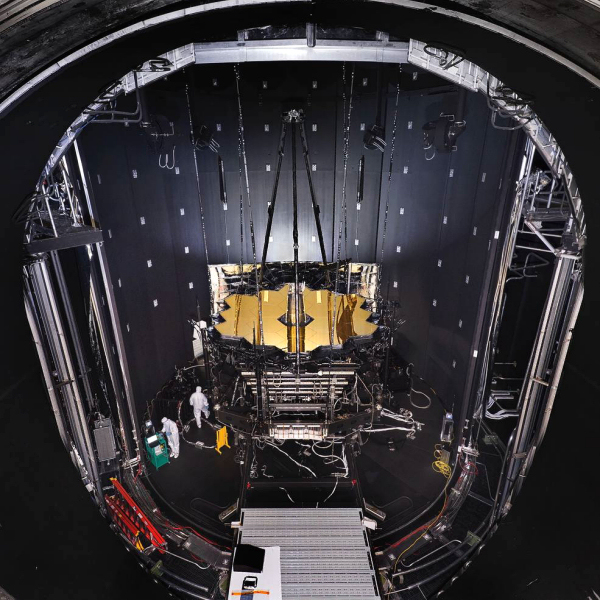 |
| The James Webb Space Telescope's combined Optical Telescope element / Integrated Science instrument module (OTIS) in Chamber A, on 10 July 2017. Credit: NASA/Chris Gunn |
One of Europe's key contributions to the James Webb Space Telescope's mission to unravel the secrets of the Universe is the Mid-Infrared Instrument (MIRI). This state-of-the art instrument has been developed jointly by a nationally funded European Consortium, under the auspices of ESA, and NASA's Jet Propulsion Laboratory (JPL) in the USA.
By imaging distant galaxies in infrared light, MIRI will help scientists to understand the evolution of the Universe and search for radiation emitted by the first stars and galaxies as they flickered into view – an event known as "first light."
In order to detect the faint infrared radiation coming from these remote galaxies, MIRI must be cooled to only 6 degrees above absolute zero – making it by far the coldest instrument on board the space telescope.
This refrigeration process is undertaken by an advanced cryogenic cooler that was provided by JPL and specially designed for MIRI. The cooler's components are spread throughout the huge observatory in order to help reduce the instrument's temperature to a frigid -267 degrees Celsius.
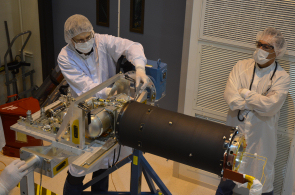 |
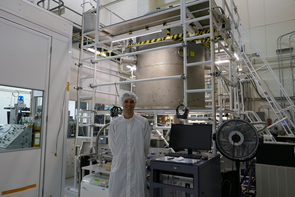 |
| Inspecting the MIRI cryocooler. Credit: NASA/JPL-Caltech |
MIRI cryocooler end-to-end test. Credit: NASA/JPL-Caltech |
For such a complex assembly, it is extremely important to be able to test the full system, in what is called an end-to-end test.
This comprehensive test of the refrigeration system was successfully concluded at JPL's California facility in early July, using a flight-spare cooler and a prototype of MIRI that was specially adapted by the European MIRI team to make sure it would react thermally in the same manner as the actual instrument on board the Webb.
The test not only confirmed that the refrigeration system can successfully cool down MIRI and keep it cold, it also gave the cooler engineering team a much better understanding of how all its components behave when connected together, and enabled them to fine-tune the operational parameters of MIRI.
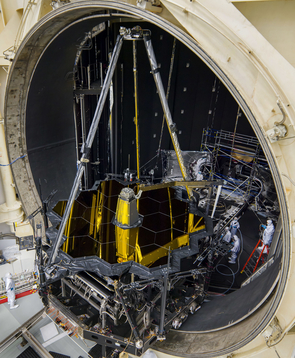 |
| The James Webb Space Telescope's Optical Telescope element / Integrated Science instrument module (OTIS) enters Chamber A at Johnson Space Center. Credit: NASA/Chris Gunn |
At roughly the same time, but more than 2000 km away, the Webb's combined Optical Telescope element / Integrated Science instrument module (OTIS) was being prepared for 100 days of cryogenic testing.
OTIS, which comprises the flight version of MIRI, together with the telescope and the three other Webb instruments, was enclosed inside a huge, airtight chamber on 10 July.
Once the door of Chamber A at NASA's Johnson Space Center (JSC) in Houston, Texas, was closed, the next step was to modify the conditions inside the chamber so that they matched the harsh, airless environment of space where the space telescope will operate for many years. Over a period of 10 days, all of the air was pumped out of the chamber to create a near vacuum. Then the internal temperature was carefully lowered to the super-cold level required for testing OTIS.
On 17 August, the flight version of MIRI was cooled down to its operational temperature of 6 Kelvin (about -267 degrees Celsius). Once cooled, the cold function tests started. These tests were aimed at verifying that MIRI was healthy and everything was still in good working order, following its transfer from NASA Goddard to JSC.
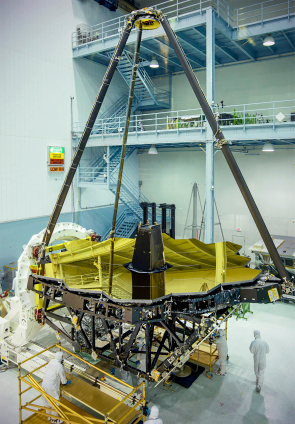 |
| The James Webb Space Telescope's Optical Telescope element / Integrated Science instrument module (OTIS) at Goddard Space Flight Center, in April 2016. Credit: NASA/Chris Gunn |
Early results indicated that there had been no change since the last cold function tests at Goddard, suggesting that everything was as it should be.
The first optical tests at JSC started at the beginning of September. These tests are referred to as 'half-pass' tests, because light from artificial stars mounted in the structure that can been seen at the centre of the primary mirror only passes through half of the telescope's optics - specifically the tertiary mirror and the fine steering mirror which will be used in orbit to reflect the light around the telescope's focal plane and into the scientific instruments.
The tests provided the high signal-to-noise images that are needed to accurately check the focus of MIRI and its alignment to the main telescope.
The first trial images taken by MIRI, obtained days before the tests commenced, had already showed that this alignment is very good, with no sign of any changes since the previous test campaign at Goddard in 2016.
Testing was able to continue, despite the floods and damage wrought by hurricane Harvey to the Houston area in late August. The OTIS test team, including several MIRI team members, were asked to undertake long shifts, as only essential personnel remained on site.
Beds were brought in so that they could stay and rest when weather conditions did not allow safe travel. During windows of relative calm, NASA provided large SUVs so that they could access and leave the site safely. During this period, Tim Grundy, an engineer at STFC RAL Space in the UK, was even able to run tests remotely from the UK, helping to minimise any delays caused by the hurricane.
Once the weather conditions returned to normal, testing returned to its normal hectic pace. This included other tests of the instruments, as well as the 'one-and-a-half' pass test of the telescope. This test made it possible to successfully check out the full optical train of the telescope, including the 6.5 m diameter primary mirror and its secondary mirror.
On 27 September, a review involving the MIRI team members concluded that all of OTIS's planned cryogenic tests had been successfully executed and that no additional testing was needed.
This opened the way for the warm-up phase, during which MIRI, the telescope and the other instruments would be carefully brought back to room temperature. This phase is still ongoing and should conclude around mid-October.
About The James Webb Space Telescope
The James Webb Space Telescope will be a general-purpose observatory with a 6.5-metre telescope optimised for infrared observations and a suite of four astronomical instruments capable of addressing many of the outstanding issues in astronomy. The primary aim is to examine objects that formed shortly after the birth of the Universe in the Big Bang, almost 14 billion years ago. Further aims include: looking at how galaxies form; the birth of stars; and the search for protoplanetary systems and the origin of life, including the study of exoplanets. The James Webb Space Telescope is a joint project of NASA, ESA and the Canadian Space Agency. It is scheduled for launch in Spring 2019 on an Ariane 5 and will operate approximately 1.5 million kilometres from the Earth in an orbit around the second Lagrange point (L2) of the Sun-Earth system.
About MIRI
The Mid-Infrared Instrument (MIRI) is one of four instruments on the James Webb Space Telescope. MIRI will provide direct imaging, medium- and low-resolution spectroscopy, and coronagraphic imaging. It is expected to make important contributions in all of the primary science aims of the mission. MIRI was developed as a partnership between Europe and the USA – the main partners are a consortium of nationally funded European institutes (the MIRI European Consortium), the Jet Propulsion Laboratory (JPL), ESA, and NASA's Goddard Space Flight Center.





